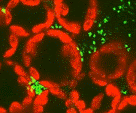Plant Pathology Department
ORCID IDs
Document Type
Article
Date of this Version
2002
Citation
Hoffman, D. D., Diers, B. W., Hartman, G. L., Nickell, C. D., Nelson, R. L., Pedersen, W. L., Cober, E. R., Graef, G. L., Steadman, J. R., Grau, C. R., Nelson, B. D., del Rio, L. E., Helms, T., Anderson, T., Poysa, V., Rajcan, I., and Stienstra, W. C. 2002. Selected soybean plant introductions with partial resistance to Sclerotinia sclerotiorum. Plant Dis. 86:971-980.
Abstract
Sclerotinia stem rot, caused by Sclerotinia sclerotiorum, is a major soybean (Glycine max) disease in north-central regions of the United States and throughout the world. Current sources of resistance to Sclerotinia stem rot express partial resistance, and are limited in number within soybean germ plasm. A total of 6,520 maturity group (MG) 0 to IV plant introductions (PIs) were evaluated for Sclerotinia stem rot resistance in the United States and Canada in small plots or in the greenhouse from 1995 to 1997. Selected PIs with the most resistance were evaluated for resistance in the United States and Canada in replicated large plots from 1998 to 2000. The PIs in the MG I to III tests in Urbana, IL were evaluated for agronomic traits from 1998 to 2000. The selected PIs also were evaluated with an excised leaf inoculation and petiole inoculation technique. After the 1995 to 1997 evaluations, all but 68 PIs were eliminated because of their susceptibility to Sclerotinia stem rot. In field tests in Urbana, higher disease severity in selected MG I to III PIs was significantly (P < 0.05) associated with taller plant heights and greater canopy closure. All other agronomic traits evaluated were not associated or were inconsistently associated with disease severity. MG I to III PIs 153.282, 189.931, 196.157, 398.637, 417.201, 423.818, and 561.331 had high levels of resistance and had canopies similar to the resistant checks. The resistance ratings from the petiole inoculation technique had a high and significant (P < 0.01) correlation with disease severity in the MG I and II field tests. The partially resistant PIs identified in this study can be valuable in incorporating Sclerotinia stem rot resistance into elite germ plasm.



Comments
U.S. government work.